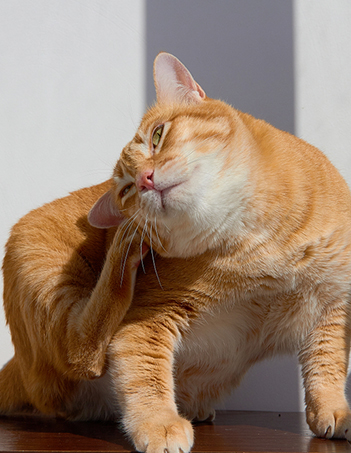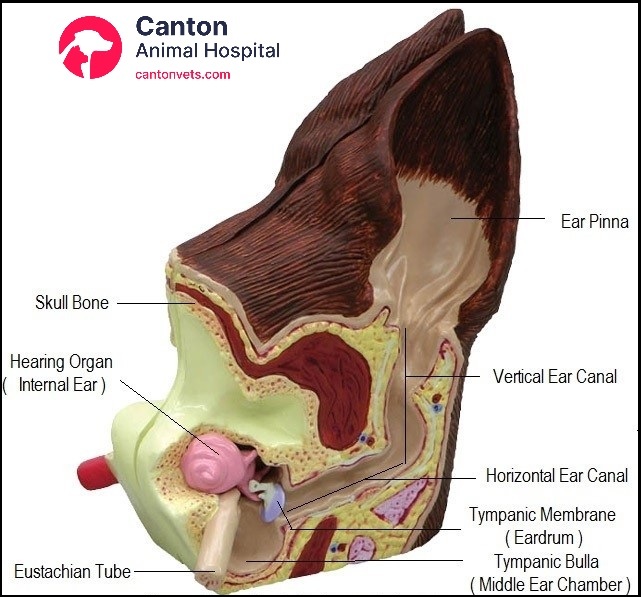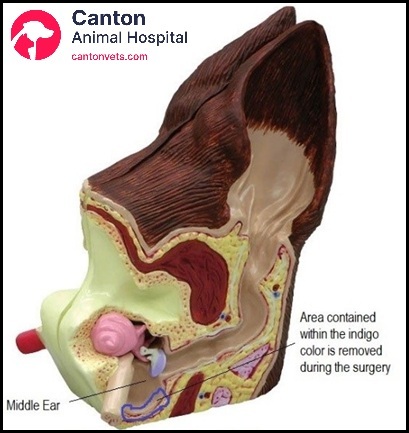Home | Surgeries | Ventral Bulla Osteotomy (VBO) in Dogs and Cats
Ventral Bulla Osteotomy (VBO) in Dogs and Cats
Ventral Bulla Osteotomy (VBO) in Dogs and Cats
Ventral Bulla Osteotomy (VBO) is a specialized surgical procedure performed to treat chronic or severe diseases of the middle ear in dogs and cats. This surgery is most commonly indicated for conditions such as persistent otitis media, inflammatory polyps—particularly in cats—or when an infection or growth is inaccessible through the external ear canal. In such cases, VBO allows direct surgical access to the tympanic bulla, enabling thorough cleaning and removal of diseased tissue.
At Canton Animal Hospital, we use VBO to resolve complex middle ear conditions while preserving the integrity of the ear canal and flap. The procedure is especially beneficial in cats, where nasopharyngeal and aural polyps are the most frequent cause of middle ear disease. VBO is also indicated when polyps or infected material extend into the auditory tube or throat, causing secondary signs such as nasal discharge, sneezing, head tilt, or facial nerve dysfunction. to treat unresolved middle ear infections, inflammatory polyps, and neoplastic conditions. This procedure allows direct access to the middle ear through an incision made on the underside of the neck. By avoiding the external ear canal, VBO preserves the integrity of the ear flap and is especially effective in cats, where nasopharyngeal and aural polyps are the most common indication.
VBO is also useful in situations where drainage from the middle ear is blocked or where abnormal tissue—like a polyp—grows through the auditory tube and extends into the throat. In cats, these growths can cause sneezing, nasal discharge, gagging, and voice changes. If polyps extend toward the ear canal, pets may exhibit head shaking, ear discharge, and changes in pupil size. such as polyps can lead to chronic discomfort, neurologic symptoms, or recurring illness in pets.
At Canton Animal Hospital, we offer Ventral Bulla Osteotomy (VBO) as a targeted surgical procedure to treat diseases of the middle ear (tympanic bulla) in dogs and cats. This approach is typically used for cases involving chronic otitis media, inflammatory polyps, or unresolved middle ear infections that are not responsive to medication or less invasive techniques.
VBO is often the preferred surgical option when the ear canal is intact, but middle ear disease is present. It is also used as a follow-up procedure in rare cases of infection recurrence after TECA-BO or when polyps extend into the bulla. This technique allows precise access to the middle ear through an incision made on the underside (ventral aspect) of the neck, avoiding disruption to the external ear canal.
Featured Resources

We Welcome New Patients!
We're always happy to give your furry friend care at our hospital. Get in touch today!
Contact Us
Indications for Ventral Bulla Osteotomy
VBO may be recommended when pets suffer from any of the following conditions affecting the middle ear:
Chronic or recurrent otitis media (middle ear infection)
Nasopharyngeal or aural polyps (common in cats)
Residual infection or debris after TECA surgery
Congenital abnormalities or cysts of the bulla
Tumors affecting the middle ear

Anesthesia and Surgical Approach
VBO is performed under general anesthesia, which includes pre-anesthetic pain control, IV induction, and gas anesthesia during the procedure. This ensures that pets remain comfortable and pain-free. The goal of the surgery is to open the middle ear cavity from below the jaw and remove any infected tissue or growths.
Our anesthetic protocol includes:
Pre-anesthetic sedatives and pain control with CRI analgesia
IV induction for safe intubation and airway management
Inhalant anesthesia and oxygen support
Continuous monitoring including blood pressure, oxygen saturation, and ECG

Surgical Steps:
A small incision is made on the underside of the neck, just behind the jawbone, to access the bulla.
The digastricus muscle is gently retracted to expose the tympanic bulla.
The bulla is carefully opened and cleaned to remove infection, polyp tissue, or foreign debris.
If only infection is present, the inflamed lining is removed, and the cavity is flushed with sterile saline.
If a mass or polyp is present, it is removed in its entirety. A sample may be sent for biopsy or bacterial culture.
The surgical site is flushed, checked for bleeding, and closed with sutures.
In some cases, rubber drains are temporarily placed in the neck to allow drainage of infection. These are usually removed within two weeks.
An Elizabethan collar is placed post-op to prevent trauma during healing.
Post-Operative Care and Recovery
Recovery following VBO surgery is generally smooth with proper at-home care and follow-up visits. Most pets begin to show improvement within days of surgery, especially if infection or polyps were causing neurological signs.
Hospital stay is typically 1–2 days for pain management and observation
Oral medications including antibiotics and anti-inflammatories are sent home
Suture removal is scheduled 10–14 days post-op
Recovery time is generally 2–4 weeks depending on the extent of disease.
Prognosis and Expected Outcomes
The prognosis for pets undergoing VBO is generally very good, particularly when performed early in the course of the disease. Early intervention can minimize long-term nerve damage or recurrence of polyps. Recovery tends to be faster and outcomes more consistent in cats than dogs, particularly for polyp-related cases.
Most pets respond well to VBO, with resolution of infection or polyp-related signs
Temporary nerve-related side effects (Horner’s syndrome, facial weakness) may occur but often resolve over time
Follow-up rechecks ensure proper healing and detect rare recurrence early.
Benefits of Ventral Bulla Osteotomy
Direct access to the middle ear with minimal trauma to external ear canal
Ideal for cases where the ear canal is healthy, but middle ear disease persists
Effective treatment for cats with nasopharyngeal or aural polyps
Lower recurrence rate when paired with complete polyp removal
Potential Risks and Complications
While the risk of complications with VBO is low, pet owners should be aware of possible side effects. These may include:
Horner’s syndrome – Seen in about 80% of cats post-surgery; causes third eyelid elevation, pupil constriction, and mild eyelid droop. Usually resolves with time.
Vestibular signs – Such as head tilt or loss of balance; more common in cases with long-standing infections. Often improves post-operatively but may persist in some dogs.
Facial nerve paralysis – Rare but may cause temporary drooping of lips or inability to blink. This complication usually resolves within a few weeks.
Persistent infection – May require a second surgery or change in antibiotic therapy.
Recurrence of inflammatory polyps – Rare when the mass and its root are fully excised. Surgical success rate is around 80%.
Breathing or snorting issues – May result from polyp extension into the throat or discharge draining through the auditory tube.
Pain upon opening the mouth – Usually short-term due to inflammation near the jaw joint (TMJ)., VBO carries a small risk of complications, though they are uncommon when performed by experienced veterinary surgeons. The anatomy of the middle ear is complex and closely associated with nerves and blood vessels, which must be carefully navigated.
Summary Table: Ventral Bulla Osteotomy Overview
Feature | Details |
Surgery Name | Ventral Bulla Osteotomy (VBO) |
Ideal Candidates | Dogs and cats with middle ear infections or inflammatory polyps |
Common Indications | Chronic otitis media, nasopharyngeal polyps, middle ear tumors |
Anesthesia Type | General anesthesia with pre-op and intra-op monitoring |
Hospitalization Time | 1–2 days for recovery and observation |
Recovery Time | 2–4 weeks, with full healing and improvement in symptoms |
Success Rate | Approximately 80% for inflammatory polyps with full removal |
Potential Complications | Horner’s syndrome, facial nerve paralysis, persistent infection |
Follow-Up | Suture removal at 10–14 days, plus rechecks for healing |
Schedule a Surgical Evaluation
If your pet has a middle ear infection or suspected polyp, Canton Animal Hospital provides skilled surgical care through Ventral Bulla Osteotomy. Our team will evaluate your pet’s condition and discuss whether VBO is the most appropriate option.
Call us today or Request an Appointment Online to schedule a consultation.
Frequently Asked Questions (FAQs) About Ventral Bulla Osteotomy
If you're considering VBO surgery for your dog or cat, you likely have questions about what to expect. This section answers the most common concerns pet owners have regarding the procedure, recovery, and outcomes.
Featured Resources

We Welcome New Patients!
We're always happy to give your furry friend care at our hospital. Get in touch today!
Contact Us